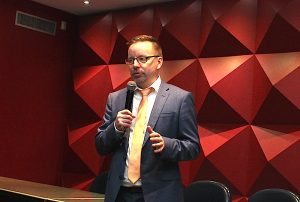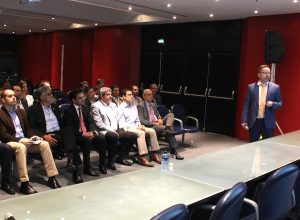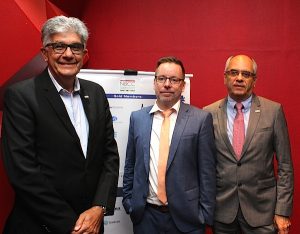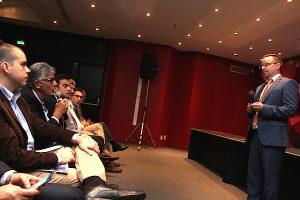 During an event on December 13, 2017, Esa Jokioinen, Rolls-Royce VP, invited NBCC associates to embark on a journey that will transform the maritime industry. Mr. Jokioinen works with sales and marketing in the Ship Intelligence Unit of Rolls-Royce Marine and was the keynote speaker of the event.
During an event on December 13, 2017, Esa Jokioinen, Rolls-Royce VP, invited NBCC associates to embark on a journey that will transform the maritime industry. Mr. Jokioinen works with sales and marketing in the Ship Intelligence Unit of Rolls-Royce Marine and was the keynote speaker of the event.Throughout his career, Mr. Jokioinen has been working with conceptual design of ships with specific focus on machinery- and propulsion systems, ship automation and energy efficiency. He joined Rolls-Royce in March 2013, and earlier this year, a new business unit on ship intelligence was established – to develop on novel digital solutions to the maritime industries including equipment health monitoring, energy optimization as well as solutions for remote controlled and autonomous vessels.
«Ship intelligence means two lines of development – intelligent asset management and remote and autonomous operations. The first commercial products will be available within shortly», Mr. Jokioinen said.
 According to the Rolls-Royce executive, intelligent asset management means that there will be fundamental changes to the way we do business, and he also gave examples of tools that Rolls-Royce Marine is developing:
According to the Rolls-Royce executive, intelligent asset management means that there will be fundamental changes to the way we do business, and he also gave examples of tools that Rolls-Royce Marine is developing:
A tool for energy management that will reduce fuel and energy consumption on board, an onboard decision support tool to optimize operations real-time. An integrated platform for health management systems, as well as an intelligent awareness system, that is a new type of system for the bridge – an advisory solution for the crew during transit and port arrival, are some examples of revolutionizing solutions. For some of the pilots, Rolls-Royce is looking for customers to test the solutions.
«The whole point is to provide the capability for vessel monitoring, remote assistance, dynamic maintenance planning and more intelligent field services. We also have new kind of service contracts where we would share the responsibility for downtime, and we work on integration and wants to develop one interface across multiple vendors of equipment.»

The speaker with Rachid Felix and Paulo Rolim.
The fundamental steps of a digitalization process are describe, diagnose, prescribe and automate. According to Mr. Jokioinen, this means that you need to map the current status and get the data, understand why something is happening before establishing a predictive advisory. The last step is automatic actuation – a final step leading to autonomous vessels.
Rolls-Royce Marine is also a front runner in the development of remote controlled and autonomous vessels.
«The main benefit is more efficient and safer operations. We aren´t looking to eliminate manning, but reduce it, and studies are being conducted into what kind of vessels that would benefit the most. There are huge costs to be saved, and it will probably be less expensive to build autonomous vessels. Rules and regulations are not in place yet, but I expect to see remotely operated local vessels within a couple of years. Rolls-Royce is working on remote controlled tug in Copenhagen», Mr. Jokioinen said, and presented videos on the project.

Q&A session.
Urbanization, climate change and resources scarcity, the shift in global economic power, demographic and social changes and technological breakthroughs are all powerful transformative forces that influence shipping industry.
:

